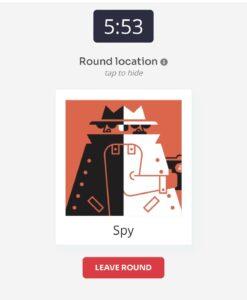
I went to the Game Night and played Spyfall from https://www.spyfall.app/ with 7 other people. This game originated from a Russian card game that is also called SpyFall, and it was designed by Alexandr Ushan. This online version I played can accommodate 4 to 12 people, and it is suitable for both a group of friends and a group of strangers who are 12+ years old. The players need to know the locations on their cards and be able to ask appropriate questions. I also found that the age range for the largest group of players of Spyfall is 18-24 years old. So I assume this game is very popular among college students!
This is a zero-sum unilateral competition outwit game. At the start of the game, each player gets either a location card or a spy card. All the players who receive the location card share the same location, but they are assigned different roles or occupations that are related to this specific location. The procedure for the game goes like this: players ask questions to one another to find out who’s the spy by voting. There are several simple rules: the person who just answered a question gets to pick another person and ask that person a question. Also, there is an around 8-minute timer for the game to mark the end of the questioning and answering session. When the time is up, players discuss who they think the spy is and vote for the person based on the answer they give. The spy can also reveal their identity and make a guess of the location. They will win immediately if they guess the location right. The boundary of the magic circle of this game is formed by the phones people are holding in their hands and using to look at their location/spy cards.
A similar game I played before is Who is the Undercover. There are several main differences. First, in Who is the Undercover, the cards do not limit to locations, and they usually contain objects. Second, it doesn’t have the additional occupation information, so it lacks the role-playing fun. Third, the undercover does not get a card that says they are the spy or undercover, which I think is the better mechanism here. Instead, they receive a card that is in the same category as the card the majority of players get. During each round, each player describes the object. After each round, the players vote one player out. Similar to the rule of Spyfall, the undercover can also announce their identity and make their guess during the game. If they guess correctly, they win. I think Who is the Undercover is more fun for the undercover because they also get a word and have a higher possibility of guessing the right word. I think Spyfall is more fun for the non-spies because they also get to do a little role-play.
The game was very fun because sometimes people give very vague questions and answers, and sometimes they give absurd answers that are up to interpretation. Also, it was my first time playing the game and I enjoyed how simple the rules are and I could quickly understand how to play it.
One moment of particular success for me as a spy was when a player vouched for me because they interpreted my answers differently even though I clearly gave wrong answers. I think the challenges for this game for the non-spies are to ask sharp questions and give vague answers but also leave some hints to people on the same team. Some other successes I noticed in other people were to leave subtle hints to others so that they would have a lower chance of being voted out.
Having been both a spy and a non-spy, I think being a spy is definitely more difficult and I want to make the spy feel more involved and not feel lost in this game. One way to improve the game is to have more spies, say 3 spies, and have the spies get a location that is similar to the location that the majority of players have.



